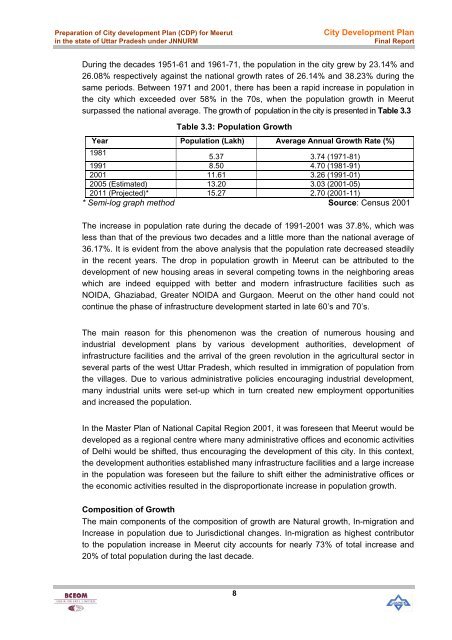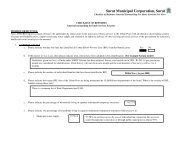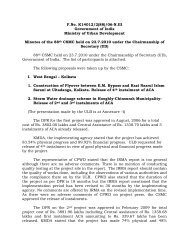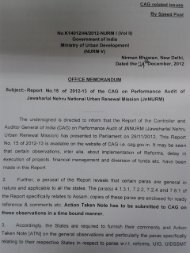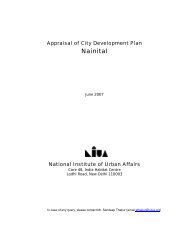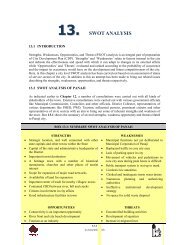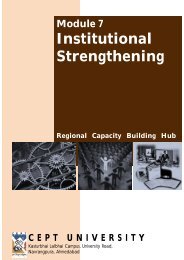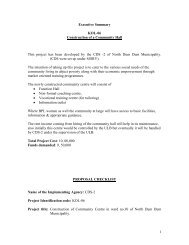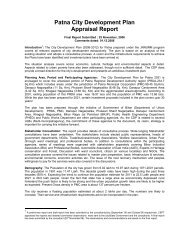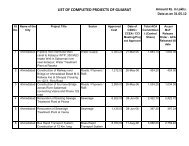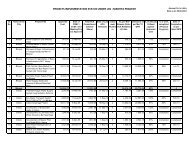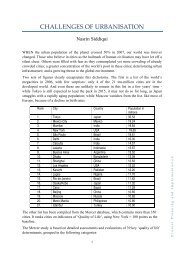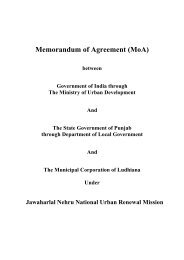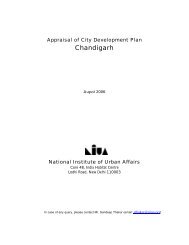CDP link - JnNURM
CDP link - JnNURM
CDP link - JnNURM
Create successful ePaper yourself
Turn your PDF publications into a flip-book with our unique Google optimized e-Paper software.
Preparation of City development Plan (<strong>CDP</strong>) for Meerut<br />
in the state of Uttar Pradesh under JNNURM<br />
City Development Plan<br />
Final Report<br />
During the decades 1951-61 and 1961-71, the population in the city grew by 23.14% and<br />
26.08% respectively against the national growth rates of 26.14% and 38.23% during the<br />
same periods. Between 1971 and 2001, there has been a rapid increase in population in<br />
the city which exceeded over 58% in the 70s, when the population growth in Meerut<br />
surpassed the national average. The growth of population in the city is presented in Table 3.3<br />
Table 3.3: Population Growth<br />
Year Population (Lakh) Average Annual Growth Rate (%)<br />
1981<br />
5.37 3.74 (1971-81)<br />
1991 8.50 4.70 (1981-91)<br />
2001 11.61 3.26 (1991-01)<br />
2005 (Estimated) 13.20 3.03 (2001-05)<br />
2011 (Projected)* 15.27 2.70 (2001-11)<br />
* Semi-log graph method Source: Census 2001<br />
The increase in population rate during the decade of 1991-2001 was 37.8%, which was<br />
less than that of the previous two decades and a little more than the national average of<br />
36.17%. It is evident from the above analysis that the population rate decreased steadily<br />
in the recent years. The drop in population growth in Meerut can be attributed to the<br />
development of new housing areas in several competing towns in the neighboring areas<br />
which are indeed equipped with better and modern infrastructure facilities such as<br />
NOIDA, Ghaziabad, Greater NOIDA and Gurgaon. Meerut on the other hand could not<br />
continue the phase of infrastructure development started in late 60’s and 70’s.<br />
The main reason for this phenomenon was the creation of numerous housing and<br />
industrial development plans by various development authorities, development of<br />
infrastructure facilities and the arrival of the green revolution in the agricultural sector in<br />
several parts of the west Uttar Pradesh, which resulted in immigration of population from<br />
the villages. Due to various administrative policies encouraging industrial development,<br />
many industrial units were set-up which in turn created new employment opportunities<br />
and increased the population.<br />
In the Master Plan of National Capital Region 2001, it was foreseen that Meerut would be<br />
developed as a regional centre where many administrative offices and economic activities<br />
of Delhi would be shifted, thus encouraging the development of this city. In this context,<br />
the development authorities established many infrastructure facilities and a large increase<br />
in the population was foreseen but the failure to shift either the administrative offices or<br />
the economic activities resulted in the disproportionate increase in population growth.<br />
Composition of Growth<br />
The main components of the composition of growth are Natural growth, In-migration and<br />
Increase in population due to Jurisdictional changes. In-migration as highest contributor<br />
to the population increase in Meerut city accounts for nearly 73% of total increase and<br />
20% of total population during the last decade.<br />
8


